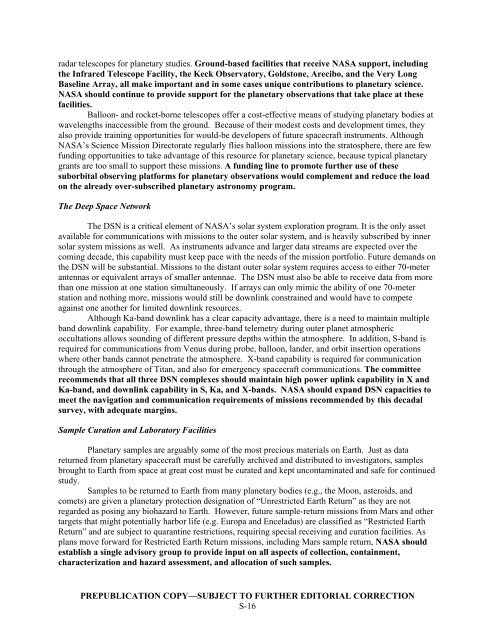Vision and Voyages for Planetary Science in the - Solar System ...
Vision and Voyages for Planetary Science in the - Solar System ...
Vision and Voyages for Planetary Science in the - Solar System ...
Create successful ePaper yourself
Turn your PDF publications into a flip-book with our unique Google optimized e-Paper software.
adar telescopes <strong>for</strong> planetary studies. Ground-based facilities that receive NASA support, <strong>in</strong>clud<strong>in</strong>g<br />
<strong>the</strong> Infrared Telescope Facility, <strong>the</strong> Keck Observatory, Goldstone, Arecibo, <strong>and</strong> <strong>the</strong> Very Long<br />
Basel<strong>in</strong>e Array, all make important <strong>and</strong> <strong>in</strong> some cases unique contributions to planetary science.<br />
NASA should cont<strong>in</strong>ue to provide support <strong>for</strong> <strong>the</strong> planetary observations that take place at <strong>the</strong>se<br />
facilities.<br />
Balloon- <strong>and</strong> rocket-borne telescopes offer a cost-effective means of study<strong>in</strong>g planetary bodies at<br />
wavelengths <strong>in</strong>accessible from <strong>the</strong> ground. Because of <strong>the</strong>ir modest costs <strong>and</strong> development times, <strong>the</strong>y<br />
also provide tra<strong>in</strong><strong>in</strong>g opportunities <strong>for</strong> would-be developers of future spacecraft <strong>in</strong>struments. Although<br />
NASA’s <strong>Science</strong> Mission Directorate regularly flies balloon missions <strong>in</strong>to <strong>the</strong> stratosphere, <strong>the</strong>re are few<br />
fund<strong>in</strong>g opportunities to take advantage of this resource <strong>for</strong> planetary science, because typical planetary<br />
grants are too small to support <strong>the</strong>se missions. A fund<strong>in</strong>g l<strong>in</strong>e to promote fur<strong>the</strong>r use of <strong>the</strong>se<br />
suborbital observ<strong>in</strong>g plat<strong>for</strong>ms <strong>for</strong> planetary observations would complement <strong>and</strong> reduce <strong>the</strong> load<br />
on <strong>the</strong> already over-subscribed planetary astronomy program.<br />
The Deep Space Network<br />
The DSN is a critical element of NASA’s solar system exploration program. It is <strong>the</strong> only asset<br />
available <strong>for</strong> communications with missions to <strong>the</strong> outer solar system, <strong>and</strong> is heavily subscribed by <strong>in</strong>ner<br />
solar system missions as well. As <strong>in</strong>struments advance <strong>and</strong> larger data streams are expected over <strong>the</strong><br />
com<strong>in</strong>g decade, this capability must keep pace with <strong>the</strong> needs of <strong>the</strong> mission portfolio. Future dem<strong>and</strong>s on<br />
<strong>the</strong> DSN will be substantial. Missions to <strong>the</strong> distant outer solar system requires access to ei<strong>the</strong>r 70-meter<br />
antennas or equivalent arrays of smaller antennae. The DSN must also be able to receive data from more<br />
than one mission at one station simultaneously. If arrays can only mimic <strong>the</strong> ability of one 70-meter<br />
station <strong>and</strong> noth<strong>in</strong>g more, missions would still be downl<strong>in</strong>k constra<strong>in</strong>ed <strong>and</strong> would have to compete<br />
aga<strong>in</strong>st one ano<strong>the</strong>r <strong>for</strong> limited downl<strong>in</strong>k resources.<br />
Although Ka-b<strong>and</strong> downl<strong>in</strong>k has a clear capacity advantage, <strong>the</strong>re is a need to ma<strong>in</strong>ta<strong>in</strong> multiple<br />
b<strong>and</strong> downl<strong>in</strong>k capability. For example, three-b<strong>and</strong> telemetry dur<strong>in</strong>g outer planet atmospheric<br />
occultations allows sound<strong>in</strong>g of different pressure depths with<strong>in</strong> <strong>the</strong> atmosphere. In addition, S-b<strong>and</strong> is<br />
required <strong>for</strong> communications from Venus dur<strong>in</strong>g probe, balloon, l<strong>and</strong>er, <strong>and</strong> orbit <strong>in</strong>sertion operations<br />
where o<strong>the</strong>r b<strong>and</strong>s cannot penetrate <strong>the</strong> atmosphere. X-b<strong>and</strong> capability is required <strong>for</strong> communication<br />
through <strong>the</strong> atmosphere of Titan, <strong>and</strong> also <strong>for</strong> emergency spacecraft communications. The committee<br />
recommends that all three DSN complexes should ma<strong>in</strong>ta<strong>in</strong> high power upl<strong>in</strong>k capability <strong>in</strong> X <strong>and</strong><br />
Ka-b<strong>and</strong>, <strong>and</strong> downl<strong>in</strong>k capability <strong>in</strong> S, Ka, <strong>and</strong> X-b<strong>and</strong>s. NASA should exp<strong>and</strong> DSN capacities to<br />
meet <strong>the</strong> navigation <strong>and</strong> communication requirements of missions recommended by this decadal<br />
survey, with adequate marg<strong>in</strong>s.<br />
Sample Curation <strong>and</strong> Laboratory Facilities<br />
<strong>Planetary</strong> samples are arguably some of <strong>the</strong> most precious materials on Earth. Just as data<br />
returned from planetary spacecraft must be carefully archived <strong>and</strong> distributed to <strong>in</strong>vestigators, samples<br />
brought to Earth from space at great cost must be curated <strong>and</strong> kept uncontam<strong>in</strong>ated <strong>and</strong> safe <strong>for</strong> cont<strong>in</strong>ued<br />
study.<br />
Samples to be returned to Earth from many planetary bodies (e.g., <strong>the</strong> Moon, asteroids, <strong>and</strong><br />
comets) are given a planetary protection designation of “Unrestricted Earth Return” as <strong>the</strong>y are not<br />
regarded as pos<strong>in</strong>g any biohazard to Earth. However, future sample-return missions from Mars <strong>and</strong> o<strong>the</strong>r<br />
targets that might potentially harbor life (e.g. Europa <strong>and</strong> Enceladus) are classified as “Restricted Earth<br />
Return” <strong>and</strong> are subject to quarant<strong>in</strong>e restrictions, requir<strong>in</strong>g special receiv<strong>in</strong>g <strong>and</strong> curation facilities. As<br />
plans move <strong>for</strong>ward <strong>for</strong> Restricted Earth Return missions, <strong>in</strong>clud<strong>in</strong>g Mars sample return, NASA should<br />
establish a s<strong>in</strong>gle advisory group to provide <strong>in</strong>put on all aspects of collection, conta<strong>in</strong>ment,<br />
characterization <strong>and</strong> hazard assessment, <strong>and</strong> allocation of such samples.<br />
PREPUBLICATION COPY—SUBJECT TO FURTHER EDITORIAL CORRECTION<br />
S-16











